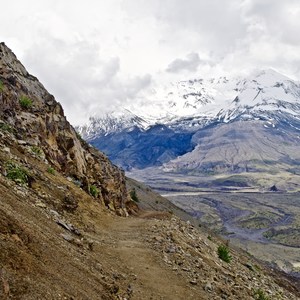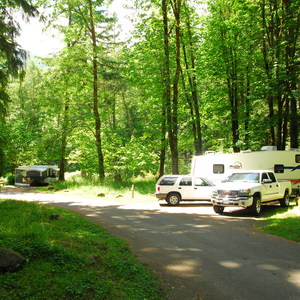You are here
The South Coldwater Trail in Mount St. Helens National Volcanic Monument kicks off immediately with a solid incline. For the next 3.6 miles, you’re consistently gaining elevation on the way to the first major milestone of the hike – Ridge Camp. Along this first leg of the trip you have plenty of motivation to keep you going: Coldwater Lake to your left, the Johnston Ridge Observatory to your right, numerous remnants of logging equipment destroyed by the 1980 Mount St. Helens eruption, and, most impressively, jaw-dropping views directly into the blown-out north side of Mount St. Helens.
Once you hit Ridge Camp you will have gained 1,300 feet of the total 3,000 feet that you will gain (not counting the ups and downs along the way). Although the view to this point has been great, it’s only going to get better. As you work your way further up Coldwater Trail above Ridge Camp, you will gain another 1,200 feet over 2.5 miles heading up to the intersection of the Coldwater Trail and the Boundary Trail. The closer that you get to the Boundary Trail, the more that natural features start to pop out – from the tip top of Mount Hood to the earliest hints of Whittier Ridge and Mount Margaret.
Once you hit the intersection of the Coldwater Trail and the Boundary Trial, you’re greeted with one of the most dramatic views of the trip…to your right the open crater of Mount St. Helens seems to tower over the landscape while to your left Mount Adams rises over the emerald waters of St. Helens Lake. To add to the drama of the scene, thousands of trees that were blown over more than three decades ago by the Mount St. Helens eruption still float on the surface of St. Helens Lake.
For the next 3.5 miles from St. Helens Lake to the summit of Mount Margaret, you are presented with what could arguably be the best views in the Pacific Northwest. While you are twisting and turning along the Boundary Trail that hugs the mountainsides, you have constant views of Mount St. Helens, Mount Adams, Spirit Lake, Whittier Ridge, Mount Rainier and the dozens of peaks and hanging lakes in between. When you reach the 5,858-foot summit of Mount Margaret, you’ll be able to take in a full 360-degree view of the Cascade Range from well north of Mount Rainier to well south of Mount Hood. Take your time having a snack and taking pictures, since you now have 10 miles back to the car to complete your 20-mile round trip.
When heading through the Mount Margaret Backcountry, a telephoto lens and/or binoculars are highly recommended. In the summer and fall when wildlife is active you are likely to see elk, mountain goats, deer, numerous hawks and eagles, and marmots and other smaller creatures.








Comments
Sign In and share them.